The government should abstain from politicizing the bureaucracy
Relevance: GS IV (Ethics and Integrity)
- Mains: Separation of Power; Whistleblowers; politicization of bureaucracy’; Issues between politics and bureaucracy;
Why in News?
Recently central government appointed “District Rath Prabhari” for ‘yatra’ to highlight the achievement of the government in view of upcoming elections. This has led to opposition leaders alleging ‘politicization of bureaucracy’.
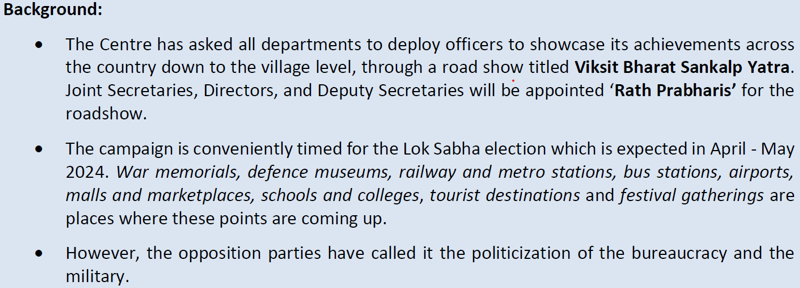
Challenges due to politicizing of bureaucracy and military before/during elections:
- Separation of Power: India’s constitutional scheme of governance envisages the separation of power among the three arms of the state — the executive, the judiciary and thelegislature — and also a line of separation between the bureaucracy and the military from the political executive. While both the bureaucracy and the military are strictly under the control of the political executive, they are insulated from partisan politics.
- Credibility in Election Process: The extensive election process in India has largely retained its credibility because of the bureaucratic impartiality demanded by the system.
- Morals and standards: The military’s involvement in any kind of domestic politics is considered anathema. Civil and military officials are expected to remain loyal to the government elected by the citizens, regardless of their personal ideological inclination.
Impact of politicizing of bureaucracy and military:
- Inefficient bureaucrats: Bureaucrats are supposed to be neutral. When they favour a political group, they might not treat everyone equally. As decision-making can be based on what’s politically beneficial rather than what’s good for the public. This can slow things down and lead to poor choices.
- Non-transparent culture: Mixing politics and bureaucracy can sometimes lead to corrupt practices, where power and money change hands improperly. Thus, eventually, public’s trust will be eroded.
- Hampers the development and democratic stability: Political interests can be short-sighted. If bureaucrats cater to these, the country’s long-term growth might suffer.
Way Ahead:
- Stronger and Transparent Processes: Need to have independent agencies that can monitor and check the actions of bureaucrats. These agencies should ensure that rules are being followed. If people can see how decisions are made, it’s harder for politics to unduly influence the process. “Open and clear methods are the keys!”
- Protection for Whistleblowers: People who speak out against wrong practices should be protected so they aren’t afraid to come forward.
- Training and Awareness: Bureaucrats should be trained to understand the importance of neutrality and the dangers of political influence. Instead of positions being filled due to political connections, they should be based on skill and capability.
- Regular Rotation of Officers: Moving bureaucrats to new posts regularly can help prevent them from developing too close ties with local biased political figures.
If principles and institutions are undermined, the damage may well be irreversible. It is the time that the interests of the nation are kept as the first priority, and practice accordingly.
PYQs
Q1. What do you understand by this statement? Explain with illustration in the contemporary times (2016)
Q2. Explain how ethics contributes to social and human well-being. (150 words)
Q3 Why should impartiality and non-partisanship be considered as foundational values in public services, especially in the present-day Socio-political context? Illustrate your answer with examples. (150 words).
Q4. It is often said that 'politics' and 'ethics' do not go together. What is your opinion in this regard? Justify your answer with illustrations. (2013)
Agricultural losses due to extreme weather events
GS Paper III
Context:
A report by the Food and Agriculture Organization (FAO) found that the frequency of extreme disaster events has risen significantly over the past 50 years.
More details on the report:
- The FAO’s report titled 'The Impact of Disaster on Agriculture and Food Security' found that Disaster events are not only becoming more frequent and severe but their impact is also expected to worsen.
- The year 2023 brought an end to the warmest decade on record, marked by unprecedented extreme weather events and large-scale disasters
- These catastrophes were worsened by ongoing conflicts and the COVID-19
- The 1970s saw approximately 100 disaster events per year. In the last 20 years, that number went up to about 400, globally.
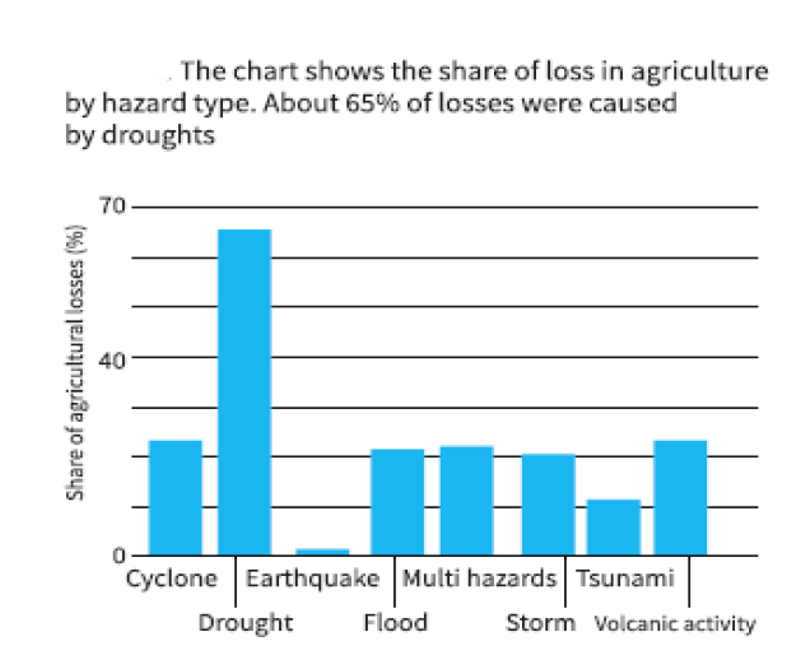
Impact of extreme weather events on world agriculture:
- Agricultural activities and livelihoods rely heavily on environmental conditions, natural resources, and ecosystems. Globally, the agriculture sector faces growing threats from hazards such as flooding, water scarcity, drought, and environmental degradation.
- For instance, in Pakistan, exceptional monsoon rainfalls in 2022 led to nearly $4 billion in damages to the agricultural sector.
- In the U.S., the National Oceanic and Atmospheric Administration estimated over $21.4 billion in crop and rangeland losses in 2022.
- Data from 88 Post Disaster Needs Assessments surveys (PDNAs) conducted from 2007 to 2022 in 60 countries indicated that agricultural losses constituted an average of 23% of the overall impact of disasters across all sectors.
- PDNAs revealed that more than 65% of losses attributed to drought affected the agricultural sector, while floods, storms, cyclones, and volcanic activities each accounted for roughly 20%.
- Losses across major crop and livestock product groups exhibited increasing trends.
Region-wise impact
- The distribution of total losses across regions from 1991 to 2021 also reflected the geographic size of each region.
- Asia bore the largest share of economic losses (45%), while Africa,Europe, and the Americas displayed similar orders of magnitude. Oceania experiences the lowest total losses.
- In absolute terms, high-income countries, lower-middle-income countries, and upper-middle-income countries reported higher losses, while low-income countries and Small Island Developing States experienced lower levels.
- However, when considering losses relative to agricultural value added, low-income countries suffered losses more than double those of upper-middle-income countries on average.
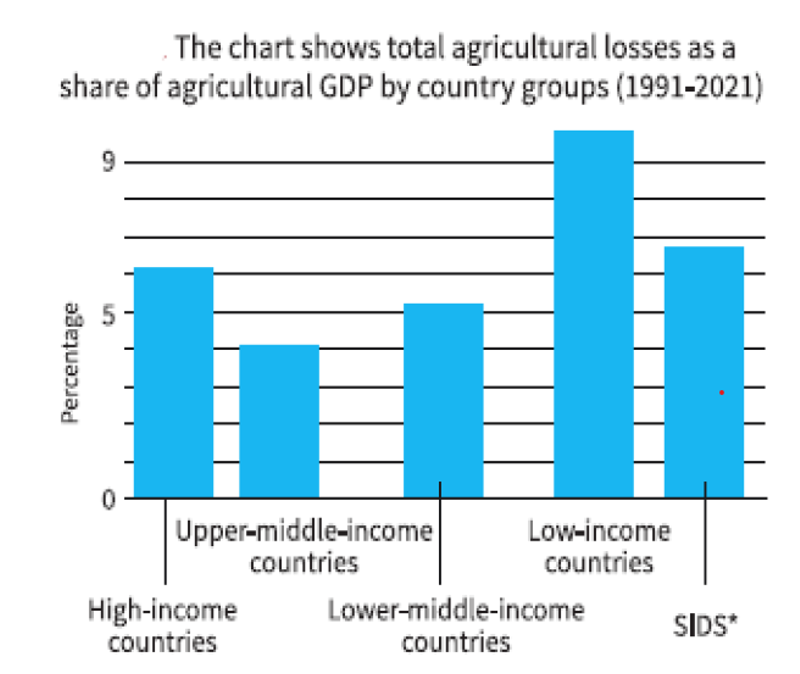
Impact on Indian agriculture
- Loss of cropping areas: In the last six years, the country lost 9 million hectares of cropped area due to floods and excess rains and 35 million hectares due to drought.
- Threat of mass hunger: The IFPRIGlobal Food Policy 2022 report cautions that by 2030, climate change could drive 90 million Indians into hunger due to reduced agricultural output and food supply chain
- Flood and cyclone: Coastal regions are prone to cyclones and flooding, which destroy rice and jute crops in regions such as West Bengal.
- Changing rainfall patterns: Erratic rain changing rainfall patterns and the delayed onset of monsoons affecting crops such as coffee, tea, and spices in Kerala and Karnataka.
- Droughts: Reduced monsoon rainfall, cold waves, and prolonged dry spells have affected the water availability for irrigation in UP, Bihar, Punjab and Haryana, impacting crops like wheat and rice.
- Irregular monsoon: In Western India, unpredictable monsoons have caused fluctuations in crop yields, particularly in cash crops like cotton and sugarcane.
- Landslides and glacial melting: In states such as Himachal Pradesh and Uttarakhand, climate change-induced glacial melting and increased landslides are affecting apples and other horticultural
Steps taken to protect agriculture from extreme weather events
On global level
- International agreements:Global climate pacts, such as the Paris Agreement, involve nations pledging to cut greenhouse gas emissions to combat climate change, addressing agriculture impacts.
- International organizations: International organizations, like the UN and FAO, work to ensure global food security by addressing the impacts of climate change on agriculture.
- Alliances: Engaging in partnerships and alliances to address climate change impacts on agriculture, such as the Global Alliance for Climate-Smart Agriculture.
On National Level
- Sustainable agriculture practices: The National Mission for Sustainable Agriculture (NMSA) aims to promote sustainable agriculture practices, improve soil health, and enhance water-use efficiency in agriculture.
- Financial protection of farmers: The Pradhan Mantri Fasal Bima Yojana (PMFBY) is a crop insurance scheme for crop loss due to extreme weather events.
- Weather forecasts: The India Meteorological Department (IMD) offers timely weather forecasts and early warnings to assist farmers in readiness and minimizing extreme weather effects.
- Research & Development: ICAR and other research institutions focus on creating climate-resilient crop varieties and pioneering farming techniques to enhance agriculture's adaptability.
Way forward
- Resilient crop varieties: Promote crop varieties resistant to extreme weather like drought and heat.
- Sustainable farming practices: Encourage conservation agriculture practices to improve soil health and reduce vulnerability to extreme weather.
- International collaboration: Cooperate globally for climate adaptation and agriculture best practice sharing for food security.
- Climate change mitigation: Prioritize adaptation, but also tackle climate change at its source by reducing greenhouse gas emissions through energy efficiency and renewables.
- Crop diversification: Encourage planting a variety of crops to reduce dependence on a few staples, lessening extreme weather risks.
- Water management: Allocate resources to enhance irrigation and water management for efficient water use, minimizing crop loss from drought.
Conclusion:
The increasing frequency of diverse extreme weather events poses a severe threat to global agriculture. Urgent action is imperative, both at the national and international levels to prioritize agriculture protection, support farmers, and fortify food security. Also, collaborative efforts are vital to mitigate climate impact and ensure sustainable, resilient agricultural practices for a secure future.
UPSC PYQ Prelims
Q1. In the context of India’s preparation for Climate-Smart Agriculture, consider the following statements (UPSC 2021)
- The ‘Climate-Smart Village’ approach in India is a part of a project Jed by the Climate change, Agriculture and Food Security (CCAFS), an international research programme.
- The project of CCAFS is carried out under Consultative Group on Internatjonal Agricultural Research (CGIAR) headquartered in France.
- The International Crops Research Institute for the Semi-Arid Tropics (CRISAT) in India is one of the CGIAR’s research centres.
Which of the statements given above are correct?
(a) 1 and 2 only
(b) 2 and 3 only
(c) 1 and 3 only
(d) 1, 2 and 3
Q2. With reference to the ‘Global Alliance for Climate-Smart Agriculture (GACSA)’, which of the following statements is/are correct? (UPSC 2018)
- GACSA is an outcome of the Climate Summit held in Paris in 2015.
- Membership of GACSA does not create any binding obligations.
- India was instrumental in the creation of GACSA.
Select the correct answer using the code given below:
(a) 1 and 3 only
(b) 2 only
(c) 2 and 3 only
(d) 1,2 and 3
Mains PYQ
Q1. Elaborate the impact of National Watershed Project in increasing agricultural production from water-stressed areas. (UPSC 2019)
Q2. Given the vulnerability of Indian agriculture to vagaries of nature, discuss the need for crop insurance and bring out the salient features of the Pradhan Mantri Fasal Bima Yojana (PMFBY). (UPSC 2016)
DNA and face-matching systems at police stations across India
GS Paper II
Context
The Union government is planning to install “DNA and Face Matching” systems at 1,300 police stations spread across police districts, commissionerate and Special Investigation Units at State headquarters.
Background
• The Criminal Procedure Identification Act (CrPI),2022 enables police and central investigating agencies to collect, store and analyse physical and biological samples, including retina and iris scans of arrested persons.
It replaced the Prisoners Act, 1920 whose scope was limited to capturing finger impressions, foot-print impressions and photographs of convicted prisoners.
• The National Crime Records Bureau (NCRB) is assigned to finalise the Standard Operating Procedure (SOP) to be followed by police officials while recording the measurements.
• The current status of collecting data - measurements such as thumb and finger impressions, and photographs of accused persons according to the old format, additionally using NAFIS.

More on the news
- The Ministry of Home Affairs (MHA) has constituted a Domain Committee consisting of representatives from State police, Central law enforcement agencies and other key stakeholders.
- A technical sub-committee for preparing the SOPs for capturing DNA as a measurement has also been constituted.
- The States have been asked to identify the locations and prepare the sites where the Measurement Collection Unit (MCU) may be established as suggested by the NCRB. NCRB will be the repository of the database at the national level.
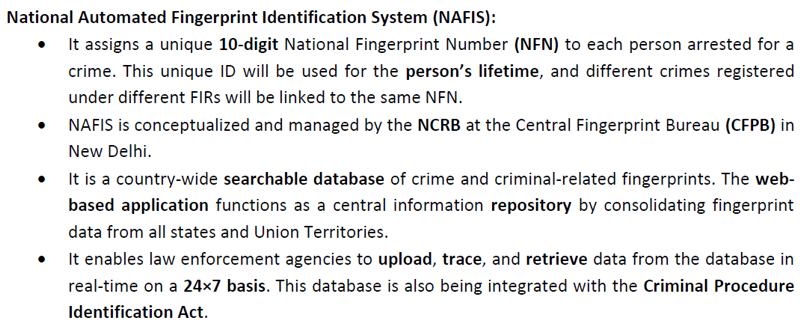
DNA profiling:
- It is the process of identifying individuals based on their unique genetic makeup. Even though people may have similar facial features, and eye and hair colour, their DNA is different, which makes this procedure useful in solving crimes more accurately.
- By comparing DNA found at the crime scene, such as blood or hair, to DNA samples from suspects, forensic scientists can either rule out or confirm a suspect. If there is a match, the police are likely to investigate the suspect more closely.
- After a convict is found guilty, their DNA is collected and stored for any future investigations.
Face matching system:
- Facial recognition technology (FRT) refers to a technique used to identify or verify individuals by their unique facial features as a biometric identifier. This technology captures a person's facial features through a digital image or video and then uses algorithms to compare that image or video to a database.
- It has numerous advantages in law enforcement – identifying criminals, improving public safety, reducing the workload of law enforcement personnel, and enhancing the accuracy of criminal investigations. However, the use of FRT also raises concerns regarding privacy and civil liberties.
Need of identification details in criminal trials:
- To establish the identity of the culprit against the person being arrested.
- To identify suspected repetition of similar offences by the same person.
- To establish a previous conviction.
Challenges
- Misuse of databases: The use of derivative data, such as "analysis" and "behavioural attributes", has raised concerns that data processing may go beyond the recording of core "measurements," and some of these measurements could be exploited for predictive policing.
- Overburdening: The "measurements" are to be taken after a conviction or arrest, even for minor offences. The necessity of such measurements for investigations is unclear, and the discretionarypower involved can lead to abuse and overburdening of the storage system. These records are kept for 75 years.
- Privacy concerns: Such collection can also result in mass surveillance, with the database being combined with other databases such as those of the Crime and Criminal Tracking Network and Systems (CCTNS).
- Tools, Training and Funding: Although MHA will cover the cost of hardware, the state will have to bear the cost of a secure internet connection and other technological and operating expenses like advanced tools and proper training of police personnel.
Way forward:
- It is crucial to define the purposes for which the "measurements" will be processed. Simply recording core measurements without conducting the necessary forensics would considerably limit their usability.
- The authorities must ensure that appropriate safeguards are identified and deployed and that only designated officials have real-time access to the measurements.
- The tools and systems used by the police must be technologically, legally, and forensically sound and accredited.
India-Canada conflict
Context
The current state of Canada-India diplomatic relations has evoked uncertainty about their future bilateral relations.
Background:
- Tensions between India and Canada over the Khalistan issue have always run high, and are the primary reason why no Indian Prime Minister made a bilateral visit to Canada between 1973 and 2015.
- From the 1970s onwards, the rise of the Khalistan separatist movement in Punjab was accompanied by an increase in support for the movement from a part of the Sikh diaspora in Canada, the U.S., and the U.K.
India-Canada relationship:
- Historical:
- India established diplomatic relations with Canada in 1947, based on strong democratic values, pluralism, culture, and people-to-people contact.
- The bilateral relations witnessed a positive push during Nehru’s visit in 1949 and Canada’s assistance in the field of nuclear technology, i.e., CIRUS (Canadian-Indian Reactor, US) in 1954.
- Economy:
- India imported merchandise worth approximately S. $ 4.05 billion in FY 2022-23 from Canada and exported about U.S. $ 4.11 billion worth of goods — indicating a largely balanced trade.
- India’s primary import items include coal, coke and briquettes, fertilizers, iron and steel, and lentils.
- India’s major items of exports are pharmaceutical products, iron and steel products, organic chemicals, and marine products, along with apparel and textiles of varied forms and variants.
- Investment:
- As per the National Investment Promotion and Facilitation Agency’s Invest India, Canada is India's 18th largest foreign investor.
- The Canadian Pension Fund (CPP) has invested in the Indian markets to about $15 billion in areas such as real estate, renewables, and the financial sector.
- More than 600 Canadian companies, including Bombardier and SNC Lavalin, have a strong presence in India. In comparison, more than 30 Indian companies, such as infotech majors TCS, Infosys, and Wipro have invested billions of dollars in Canada, creating thousands of jobs.
- Education:
- Canada has about 08 lakh students from India at present. This accounts for more than 37% of its overall international student pool.
- Under the Global Initiative of Academic Works (GIAN) Programme, around 69 Canadian facultymembers visited India for teaching assignments in Indian institutions and worked on 19 projects under the Scheme for Promotion of Academic and Research Collaboration (SPARC) to improve research ecosystems in India’s higher education institutions.
- A perfect example of academic exchange is the greatest contribution of Michael Becher, a Professor of Political Science and International Relations with the creation of the Shastri Indo-Canadian Institute in 1966, with joint headquarters in Calgary and New Delhi. The Institute was named after India’s former Prime Minister Lal Bahadur Shastri following his untimely death in 1966.
- Science and Technology:
- Both countries are working continuously to develop a low-cost solution to support healthy communities.
- One such example is of India-Canada Centre for Innovative Multidisciplinary Partnership to Accelerate Community Transformation and Sustainability (IC-IMPACTS) and Mitacs which are working in sectors of integrated water management, safe and sustainable infrastructure, and public health.
- Under the “Mission Innovation” program, India has collaborated with Canada on Sustainable Biofuels (IC4).
- Tourism:
- To further promote tourism and economic activities, Air India has started its direct flight Amritsar-Delhi-Toronto and Air Canada operates a non-stop direct flight between Mumbai-Toronto, Delhi-Toronto, and Delhi-Vancouver.
- Indian diaspora in Canada:
- People who identified Punjabi as their ethnic or cultural origin during the 2021 Canadian census formed the largest share of Indians in Canada, followed by Tamilians, Gujaratis, and Bengalis.
- More importantly, 30% of Punjabis in Canada belong to the second or third generation (persons not born outside Canada).
- In the field of politics, in the present House of Commons out of a total of 338, 22 Members of Parliament are of Indian origin.
Speed bumps in bilateral relations between India – Canada:
- The first time, the ties saw some grey clouds was in 1948 when Canada supported a plebiscite in the Indian state of Kashmir.
- The second one came in 1974 when India carried out its first nuclear test and our Canadian counterpart believed that these tests were carried out with the help of the CIRUS reactor which was against their ideology of peaceful use of nuclear energy.
- The third, came during the 1980s when Punjab was going through a militancy phase and India expressed its reservations regarding the activities of Khalistan in Canada.
- The fourth blow came in 1998 during India’s Pokhran Nuclear test.
- The fifth was linked with the crash of Kanishka airline which killed all 329 passengers on board.
- The final nail in the coffin came with Canadian Prime Minister Trudeau’s remarks on the Indian farmers’ protest in December 2020 which further deteriorated the bilateral ties
Opportunities for Canada and India to push their economies upwards:
- First, Canada can assist India in energy security, renewable energy, clean technology, bio-energy, solar, wind, and sewerage treatment technology/plants which can benefit India in its Intended Nationally Determined Contribution (INDC) targets and Swachh Bharat Mission.
- Second, trade complementarities between India and Canada can further strengthen our commercialbond through cooperation in areas such as agricultural products, Chemicals, Automobiles, Energy, Electronics, Textiles Minerals, and Information Technology.
- Third, in a recent ministerial meeting, Canada agreed to examine the request for Conformity Verification Body (CVB) status to APEDA (Agricultural and Processed Food Products Export Development Authority) for hassle-free export of Indian organic products.
- Fourth, in recent times we have witnessed a significant movement of professionals, skilled workers, students, and business travellers between the two countries which can immensely contribute to enhancing the bilateral economic partnership of both countries.
- Fifth, the public health sector is another domain where India can act and support Canada as a reliable partner in supplying generic medicines and affordable pharmaceutical products.
- Sixth, even after the economic crash due to the COVID-19 pandemic, our bilateral economic trade in 2021 in goods was around US $ 6.29 billion with a positive growth rate of 12% as compared to 2020.
- Finally, Canada and India have taken various initiatives to make our business environment more investor-friendly, and thus in the last six years, there has been an increase from US $ 5 billion to more than US $ 55 billion in portfolio investments from Canada to India
Way forward:
- As per reports, India has been steadily moving north in its “Ease of Doing Business” The implementation of Goods and Services Tax, debt, and insolvency law, as well as the Production Linked Incentive scheme, have proved beneficial for Canadian businesses in India.
- Though not a member of the Quadrilateral Security Dialogue (QUAD), it could be an opportunity for Canada to devise its nascent Indo-Pacific strategy and strengthen its ties with India as India is an active member of the QUAD.
- Both nations are also working on the “Open Skies Agreement”, which permits unlimited flights between the two countries.
- The Canadian presence in the Pacific with respect to humanitarian assistance, diaspora, strategic naval exercises, and being a member of the Five Eyes can assist India in gathering intelligence on terror networks.
- India, which is a multicultural federation with a strong and professional military that has faced intense Chinese aggression can come out as a solution to Canada’s pivot to the Indo-Pacific.
- The Commonwealth platform can also turn out to be an ideal forum for both India and Canada to highlight the global geopolitical issues and trade and non-trade barriers that act as obstacles for the world to progress as one family.
- Members of both the Canadian parliament and the Indian Diaspora can play a constructive role in cementing the bilateral ties between the two nations.
Ball Lightening
About
- It is a rare and mysterious form of lightning that appears as a luminous ball near the spot where lightning strikes.
- It moves horizontally at a speed of a few centimetres per second and can pass through closed windows; lasts several seconds and explodes at the end but is not usually destructive.
- It is also known as globe lightning and occurs during intense electrical activity in the atmosphere, but scientists have not been able to reproduce it in the laboratory.
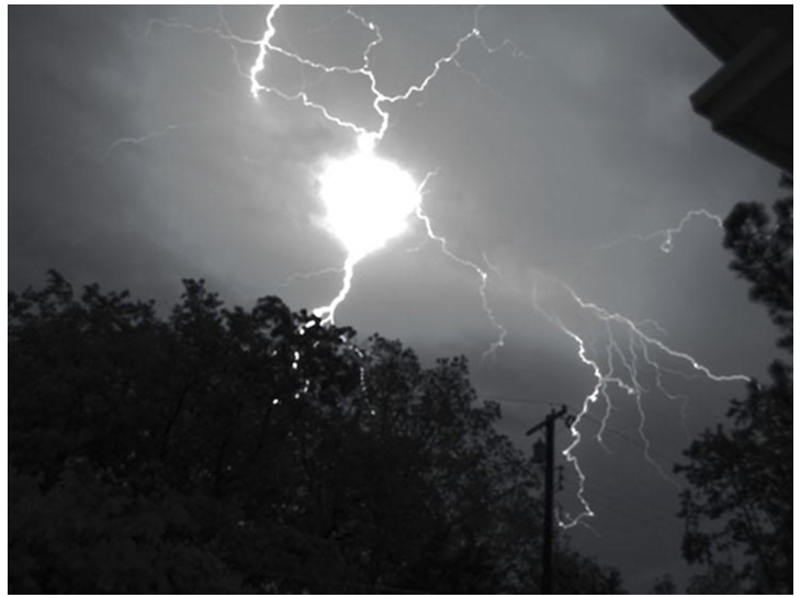
‘Do you call this equality?’- A Women Strike in Iceland
Context
Women of Iceland are protesting against inequality.
About
- On October 24, a strike, named "Kallarðuþettajafnrétti?" (Do you call thisequality?) took place in Iceland. It was led by labour unions and was inspired by a similar action in 1975.
- According to a report by The Guardian - Women in some professions still earn 21% less than men, and over 40% of women have experienced sexual or gender-based violence.
- Women in Iceland staged a one-day strike to protest against gender discrimination. They were joined by the country's Prime Minister, Katrin Jakobsdóttir.
- Women refused to work paid and unpaid jobs, including household chores and childcare, in order to bring attention to the ongoing issue of gender inequality.
- For the last 14 years, Iceland has ranked first in the World Economic Forum's Global Gender Gap Index.
Hurricane Otis
Context:
Hurricane Otis makes landfall in Mexico.
About
- Hurricane Otis, currently over the Mexican state of Guerrero near Acapulco, is rapidly losing its strength.
- It has earned the distinction of being the most powerful Pacific hurricane to make landfall.
- Otis is the fifteenth storm, tenth hurricane, eighth major hurricane, and the second Category 5 hurricane in the 2023 Pacific hurricane season.
- This formidable storm initially formed from a disturbance located hundreds of miles south of the Gulf of Tehuantepec.


